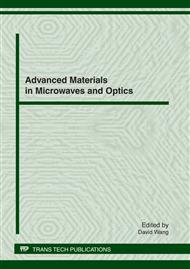[1]
A.A. Kokhanovsky, F.M. Breon, A. Cacciari, et al. Aerosol remote sensing over land: A comparison of satellite retrievals using different algorithms and instruments. Atmospheric Research 85(2007) 372-394.
DOI: 10.1016/j.atmosres.2007.02.008
Google Scholar
[2]
A. H. Strahler, J. P. Muller, MODIS Science Team Members. MODIS BRDF/ Albedo Product: Algorithm Theoretical Basis Document Version 5. 0. MODIS Product ID: MOD43, (1999).
Google Scholar
[3]
Al-Saadi J., J. Szykman, R. B. Pierce, et al. 2005 : Improving National Air Quality Forecasts with Satellite Aerosol Observations. Bull. Am. Met. Soc., 86(9), 1249-1261.
DOI: 10.1175/bams-86-9-1249
Google Scholar
[4]
Christina N. Hsu, Si-Chee Tsay, Michael D. King, et al. Aerosol Properties Over Bright-Reflecting Source Regions. IEEE Transaction on Geo-science and Remote Sensing, VOL. 42, NO. 3, 2004, 557-569.
DOI: 10.1109/tgrs.2004.824067
Google Scholar
[5]
Crystal B. Schaaf, Feng Gao, Alan H. Strahler, et al. First operational BRDF, albedo nadir reflectance products from MODIS. Remote Sensing of Environment, 2002, 83: 135-148.
DOI: 10.1016/s0034-4257(02)00091-3
Google Scholar
[6]
H. Bian, M. Chin, J. M. Rodriguez, et al. Sensitivity of aerosol optical thickness and aerosol direct radiative effect to relative humidity. Atmos. Chem. Phys., 9, 2375-2386, (2009).
DOI: 10.5194/acp-9-2375-2009
Google Scholar
[7]
Holben B N, Vermote E, Kaufman Y J, et al. Aerosol retrieval over land from AVHRR data : Application for atmospheric correction. IEEE Trans. Geosci. Remote Sens, 1992, 30: 212-222.
DOI: 10.1109/36.134072
Google Scholar
[8]
J. T. Houghton, Y. Ding, D. J. Griggs, et al. Intergovernmental Panel on Climate Change (IPCC) Climate Change 2001: The Scientific Basis. 2001. Cambridge University Press, UK. PP 944.
DOI: 10.1177/095968360301300516
Google Scholar
[9]
Kaufman Y J, Wald A E, Remer L A., et al. The MODIS 2. 1-um channel –correlation with visible reflectance for use in remote sensing of aerosol[J]. IEEE Trans. Geosci. Remote Sens., 1997b, 35(5): 1286-1298.
DOI: 10.1109/36.628795
Google Scholar
[10]
Kaufman Y J, Sendra C. Algorithm for automatic atmospheric corrections to visible and near-IR satellite imagery[J]. Int. J. Remote Sensing, 1988, 9(8): 1357-1381.
DOI: 10.1080/01431168808954942
Google Scholar
[11]
King M D, Kaufman Y J, Tanre D, et al. Remote sensing of troposphere aerosol from space : past, present, and future[J]. Bulletin of the American Meteorological Society, 1999, 80(11): 2229-2259.
DOI: 10.1175/1520-0477(1999)080<2229:rsotaf>2.0.co;2
Google Scholar


